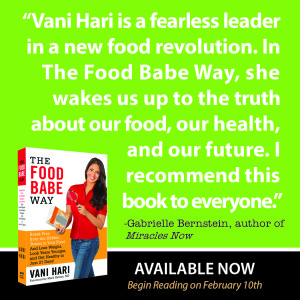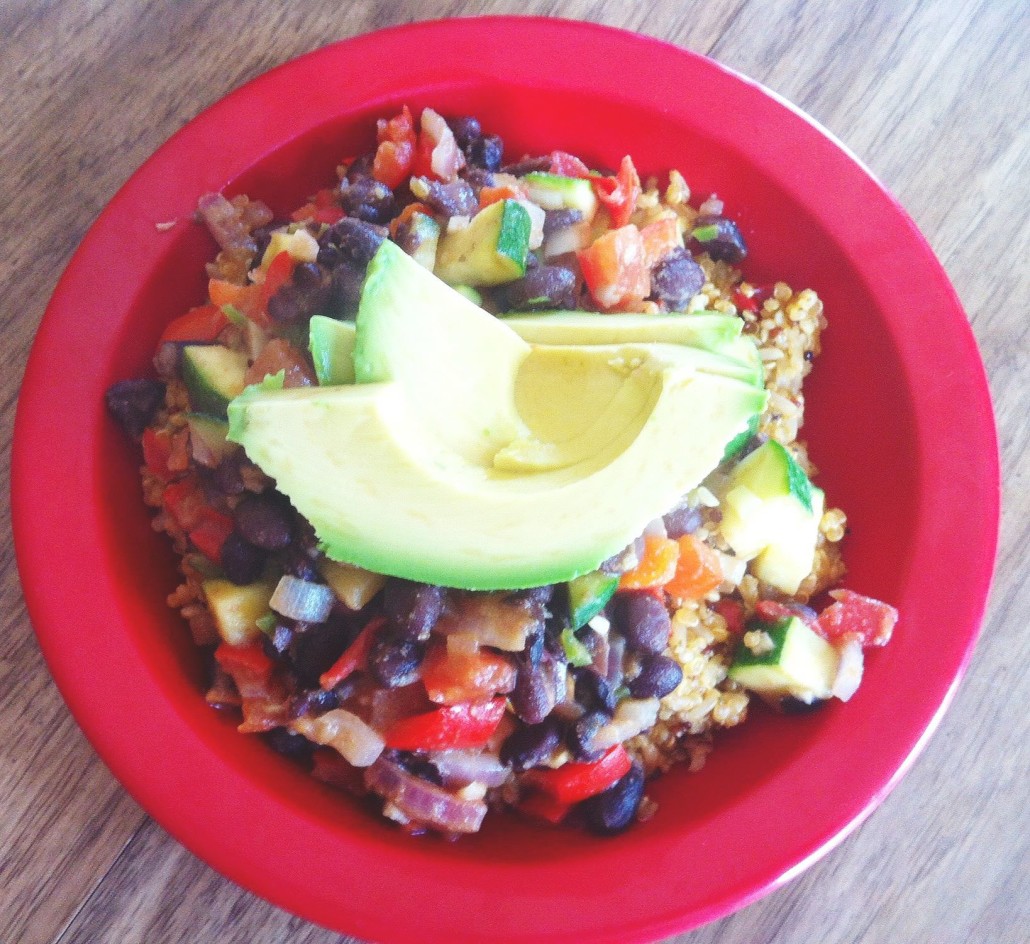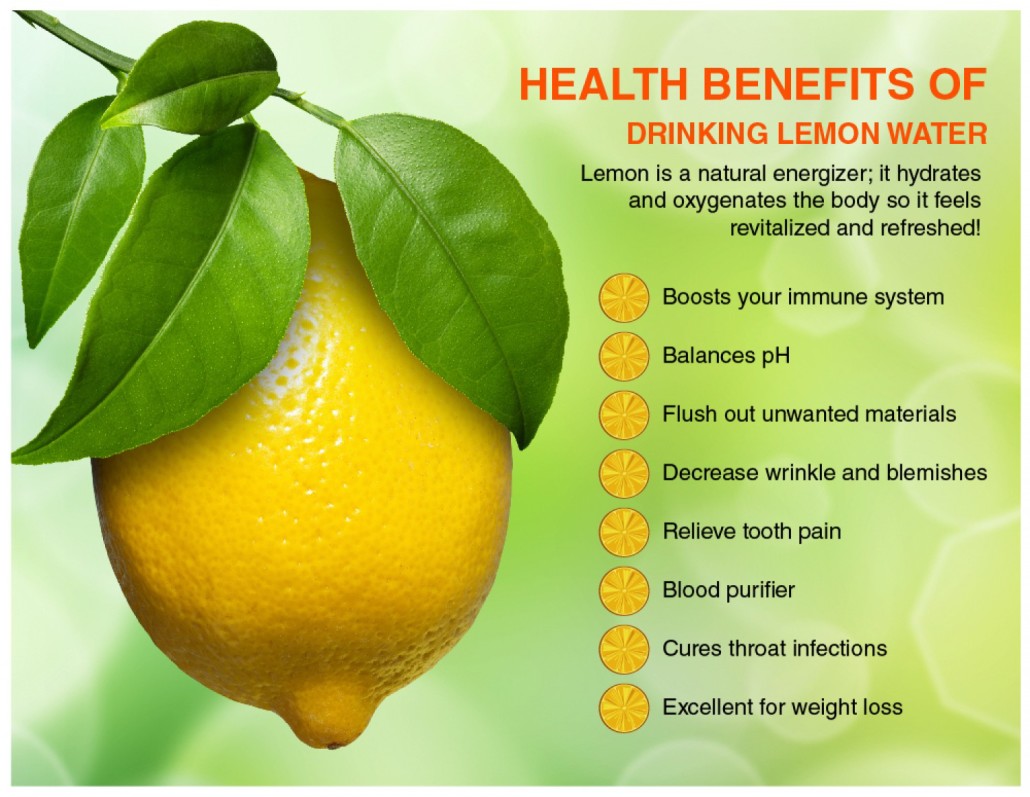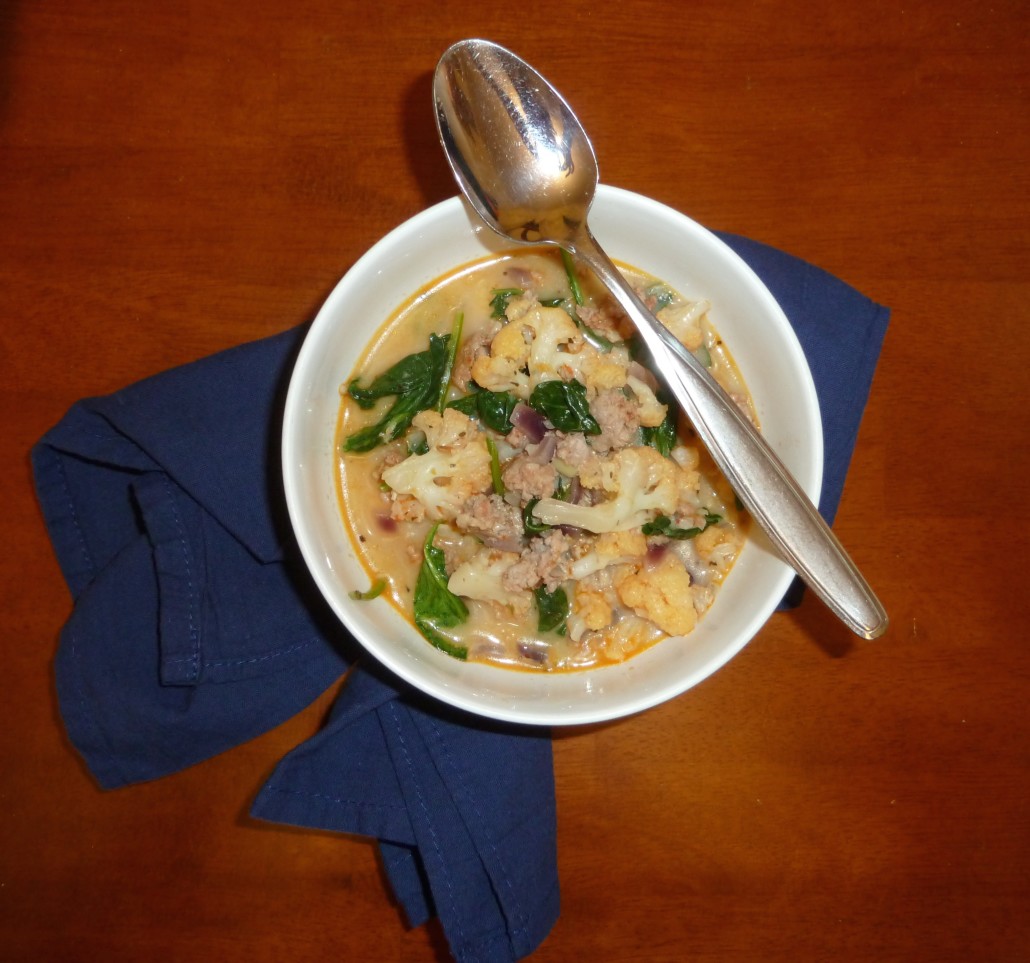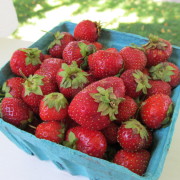Vani Hari better known as the Food Babe is shaking up the way the commercial food industry produces the foods we consume. Her new book The Food Babe Way is released nationwide on February 10, 2015. Vani is known for her investigations into the toxic ingredients that are added to our food. She has sparked a Food Revolution and is a voice for consumers worldwide. Consumers are searching for transparency in labeling and they want to know that the food they feed their families is safe. The Food Babe Way, outlines her investigations, the 15 ingredients consumers want to steer clear of, a 21 day plan to improve your health and a section full of recipes to try at home.
There was much that I loved about The Food Babe Way. I suggest everyone take the time to read it and do some research for yourself. There is no doubt that Hari will face strong opposition from select groups of people and corporations lobbying to keep the status quo. Let us all look for solutions instead of wasting energy tearing others down with personal attacks. Do not be dissuade by scare tactics. Nothing can stop an idea whose time has come.
The commerical food industry is being threaten as people demand change. On page 37 of The Food Babe Way Vani sums it up. “The FDA isn’t looking after you. They’re looking after food companies. Make no doubt about it, the food industry is in bed with the FDA. If you want to be healthy and in shape, you’ve got to take control. No government agency, big food company, or anyone else is going to do it for you. You can’t trust anyone but yourself.”
Everyday we have the ability to vote with our wallets for the types of food we want businesses to produce. We create the world we want to live in. The Food Babe Way is a step by step guide to achieving full transparency in food production and choosing to live a healthier life.
Hari encourages her followers affectionately known as the “Food Babe Army” to take action to impact their local communities. Many are now petitioning large corporations to disclose the ingredients found in our food. We talked to Vani about The Food Babe Way, here is our interview with her.
“Never doubt that a small group of thoughtful, committed citizens can change the world;
indeed, it’s the only thing that ever has.” – Margaret Mead
The Food Babe Way – An Interview With Vani Hari
What prompted you to begin investigating the foods Americans consume?
I began my food journey, like most people, by following the standard American diet. As a successful management consultant, I was either in the office eating whatever take-out was available, or I was on the road eating every meal out. Although this lifestyle allowed me to fit in with my peers and work crazy hours, it also took a huge toll on my body and I became very ill. Over the holiday season over ten years ago, I found myself in a hospital bed. I was sick, overweight, and I was ready to change! I made a personal promise that from that point on that I was going to make health my number one priority. FoodBabe.com was born in April 2011, from my years of learning, investigating and researching how to live a healthy lifestyle in this overly processed world. As I learned more about the habits needed for a healthy lifestyle and what dangerous ingredients to avoid, my friends and family begged me to start a blog in order to share everything I had uncovered. My first investigation was into my favorite yogurt chain. After the CEO responded to my writings by yanking some of the misleading marketing, I continued writing about the injustices and corrupt practices of the food industry. Over the past three years, FoodBabe.com has grown to have a readership of over 4 million inspired individuals who are seeking to lead heather lives and rid our food system of deadly ingredients. It is through the help of the entire Food Babe Army that the investigations and petitions on FoodBabe.com have been able to force some of the largest food corporations to change, including Kraft, Chick-fil-A, Chipotle, Subway, Anheuser-Busch, and Starbucks.
What do you say to those that are trying to quiet the message of full disclosure of the ingredients in our food?
Food is an emotional topic and it can be polarizing. People don’t always want to hear that the food they have been eating contains a controversial ingredient or possibly been damaging their health and this can lead to resistance. Many critics that speak out frequently against my ideas are ones that either support the chemical companies and food companies or are critical of natural therapies in general. It is my job to tell the truth and I leave it up to the consumer to choose how they react and what they do with that information.
How do you decide which companies and products to investigate?
I investigated Subway after seeing one of my dear friends at work bring in Subway everyday for lunch and it drove me crazy. I knew there were additives in the food, and food-like substances, and I wanted to know what they were so that I could tell him. After Michelle Obama went on TV and said that Subway is safe for all kids, I knew that something had to be done. It was the same thing with Chick-fil-A. I used to eat Chick-fil-A every day in college, and my friends and family continued to eat it thinking that that was a healthier fast food option. If it wasn’t for that deep desire to tell my close friends and family about this, I don’t think that I would have had the opportunity to go to their headquarters to work with them on making some changes.
I definitely think that the fastest way to get change is to target the companies. There’s only so much responsibility that you can give to the government and to regulatory agencies. For instance, after you find out that companies aren’t allowed to use a chemical in another country, and that they have reformulated their products without that chemical in other countries, I think that they have an ethical obligation to do that for all of their products here too. People resonate with the brands that are seeing on TV and buying at the grocery stores. They don’t really resonate with government bureaucracy. It takes a really long time to enact regulation in the government.
Why is it important for everyone to learn how to read food labels and know what is in their food?
Many of the food additives that the FDA deems safe, have not be studied long term and no one has studied the cumulative effect of all the food additives we are eating. The Deputy Commissioner of the FDA, Michael Taylor, recently admitted to the Washington Post, “We do not know the volume of particular chemicals that are going into the food supply so we can diagnose trends. We do not know what is going on post-market”. These food-like substances are made from chemicals that are cheap, provide zero nutritional value and improve the bottom line of food manufacturers. Fake foods do nothing for our health and in some cases could cause harm. Europe has taken a precautionary principle towards many of the additives I have investigated and banned them for their citizens. Why isn’t the United States doing the same?
What are some tips you can give us on deciphering food labels or ingredients to steer clear of?
In The Food Babe Way I highlight the top 15 sickening ingredients to avoid if you want to lose weight, feel and look years younger, along with a cheat sheet for deciphering deceptive marketing messages on food packages. Start by avoiding these ingredients at all costs:
Preservatives – Some common examples are sodium phosphate, nitrates, BHA, BHT and TBHQ. These additives are potentially cancer causing and/or endocrine disruptors. Preservatives are commonly found in cereals, crackers, snack foods, cakes. Try choosing fresh foods that do not have a long shelf life or organic brands that do not use preservatives.
MSG & hidden MSG additives – Used as a flavor enhancer, MSG is one of the most fattening ingredients that can also cause adverse reactions in some people including skin rashes, itching, hives, nausea, vomiting, migraine headaches, asthma, heart irregularities, depression and even seizures. Hidden forms of it can be listed as yeast extract, autolyzed yeast, hydrolyzed protein, natural flavor or textured protein. It is commonly found in restaurant foods, chips, dips, frozen dinners, salad dressings and soups.
Artificial Sweeteners – These may do more harm than good, they may slow down your metabolism and “train” you to crave sweets. Also, the presence of artificial sweeteners in a product doesn’t automatically mean high-calorie sweeteners aren’t present, too. Some food manufacturers use both. Look for aspartame, neotame, saccharin, sucralose, erythritol, acesulfame potassium, and acesulfame K on the label. You can also find them under brand names “Nutrasweet,” “Sweet N’ Low,” “Equal” and “Splenda.” They can be found in sodas, candy, yogurt, desserts and many other processed foods. Try and find foods that are sweetened with natural sweeteners like fruit, honey, maple syrup, 100% pure stevia or coconut palm sugar and eat these foods in moderation.
Artificial Trans Fats – These are found in partially hydrogenated oils, and ingredient that the FDA is currently considering to ban. Trans fats can raise bad cholesterol and lower good cholesterol, and are a leading cause of heart disease. They can be found in many shelf stable food items like crackers, cookies, bakery items, doughs, pies and snack foods. Try and choose foods that do not have partially hydrogenated oil listed on the label and that use healthy oils instead like olive oil and coconut oil.
Genetically Modified Organisms (GMOs) – These crops are biologically manufactured in laboratories — injected with new DNA, viruses, herbicides, insecticides and/or other chemicals — to be resistant to synthetic chemicals and are completely different than hybridizing techniques allowed by nature. The most common GMO ingredients are soy, corn, canola, zucchini, squash, and sugar beets. Most GMOs are found in processed foods. Buy certified organic foods or those that are certified by the Non-GMO project to avoid them. A list of known GMO ingredients, including their derivatives, is available on my website.
How do you suggest people get involved in their local area?
Reach out to local farmers and grocery stores and ask what can be done to help provide access to affordable, local, organic food, so that it’s available to more consumers in your community. If you are lucky enough to have one in your area, volunteer to work at a local food co-op. Also, consider starting your own petitions. In The Food Babe Way, I outline the guidelines for how to start an effective petition that works. I’m a testament to the fact that starting a petition is an easy (and super effective) way to bring about positive changes and truly transform our world. Try starting a petition yourself and you might be surprised at the impact that it makes.
What keeps you going?
I am very passionate about improving food system in this country. Sharing the truth is so powerful. I want people to know that you don’t have to be intimidated by this information and I make it very simple for people to get involved. The public is fed up with being taken advantage of. They see their families getting sick, they have family members who have died of cancer, and they want someone to hold accountable.
What is your goal? Where do you see the Food Babe Army in the next 5 years?
When everybody has access to safe and affordable food and knows exactly what is in their food, my mission will be complete. This is a movement about transparency in the food system. Everyone deserves to know exactly what they are eating and my job will not be done until we all have this information.
What can readers expect to walk away with from reading The Food Babe Way?
The Food Babe Way is a roadmap on how to live in this over-processed food world. I have made it my life’s mission to tell people the truth about what’s in their food and how it could affect their health and now in this book I get to give people this critical information. The Food Babe Way contains the 21 essential habits that I taught myself to take control of my health. This book is for anyone who is tired of the food industry hijacking their taste buds and wants to take matters in their own hands and become their own food investigator, nutritionist and food activist. We have the power to change our health faster than anyone else and I wrote this book to show people how to do just that.
Vani Hari is a revolutionary food activist, creator of FoodBabe.com and author ofThe Food Babe Way. In her work, Hari has influenced how food giants like Kraft, Subway, Chipotle, Chick-fil-A, and Starbucks create their products, steering them towards more healthful policies. She lives in North Carolina and travels around the world to speak about health and food awareness. She is currently planning her next campaign.
